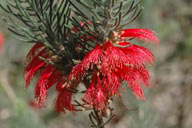In Flower This Week
A news sheet prepared by a Gardens' volunteer.
Numbers before each plant refer to temporary IFTW labels in the gardens.
Numbers in square brackets [ ] refer to garden bed Sections. Plants in flower are in bold type.
View past issues of 'In Flower This Week'.
23 December 2015
Calothamnus quadrifidus click for larger image |
We start at the Visitors Information Centre (VIC) and head towards the Myrtaceae section.
- On your left in a pot as you leave the VIC is Lobelia andrewsii [Section 221], with long thin stems of green foliage and bright blue two-lipped flowers with white centres. It is found in the wild along the coasts of New South Wales and Queensland.
- Bear left up the path behind the café, then go right to see on your left a large mat of Grevillea ‘Poorinda Royal Mantle’ [Section 124] with masses of red toothbrush flowers, which are a beacon for both birds and bees.
- Grevillea bipinnatifida ‘Jingle Bells’, [Section 124], also on your left, is a standard with deeply-divided stiff, prickly foliage and many trusses of pink and orange flowers.
- Further on your left is Scaevola ‘Mauve Clusters’ [Section 124], a mat-forming groundcover with fresh green foliage and mauve flowers.
- Also on your left is another member of the same genus, Scaevola albida [Section 124], with bright green oval foliage and mauve fan flowers. It is a prostrate shrub native to southern Australia.
- On your left as you turn the corner to go uphill is a stand of Anigozanthos flavidus [Section 119], with green flowers. All kangaroo paws are native to Western Australia, and the flowers are bird-pollinated.
- Turn right towards the Main Path and continue on this dirt path to see on your right Callistemon brachyandrus [Section 11], with grey linear foliage and red flowers with gold-tipped stamens. It certainly lives up to its common name of Prickly Bottlebrush. It is found in western New South Wales, Victoria and South Australia.
- Further on your right is Calothamnus quadrifidus subsp. asper [Section 11], with red flowers on a low bush. It is uncommon in the wild and is found north of Perth in Western Australia.
- On your left is Kardomia odontocalyx [Section 9], a medium-sized bush with many white flowers, found only in a restricted area of New South Wales and Queensland.
- Turn right downhill towards the VIC to see on your right Spyridium burragorang [Section 11] a long-flowering, medium-sized shrub with unusual white bracts surrounding a central cluster of flowers. In the wild it is confined to the Lake Burragorang district of New South Wales and is considered rare.
- On your left is Leptospermum polygalifolium subsp. transmontanum [Section 13], a light airy bush with white “tea-tree” flowers with gold centres. It occurs in the wild in the northern part of New South Wales and Queensland.
- On the right is Sannantha pluriflora [Section 12], or Tall Baeckea, a tall shrub or small tree with dark green foliage and bright white flowers with green centres. It is found in the wild along the coasts of New South Wales and Victoria.
- Also on the right is Austromyrtus tenuifolia [Section 12], a compact green bush covered in white flowers with many white stamens. It occurs naturally only around Sydney.
- Further back on your right is a tall tree with dark green foliage smothered in white blooms, Melaleuca bracteata [Section 12]. The flowers have a slight honey scent and are very popular with insects. The species is endemic to northern Australia.
- On your left Leptospermum polygalifolium subsp. polygalifolium [Section 12], is a large spreading tree covered in white flowers and mobbed by insects of all kinds. It occurs in the wild from Sydney south to the Victoria/New South Wales border.
Rosalind Walcott
![Director of National Parks [logo]](../../../../images/dnp_90px.gif)







